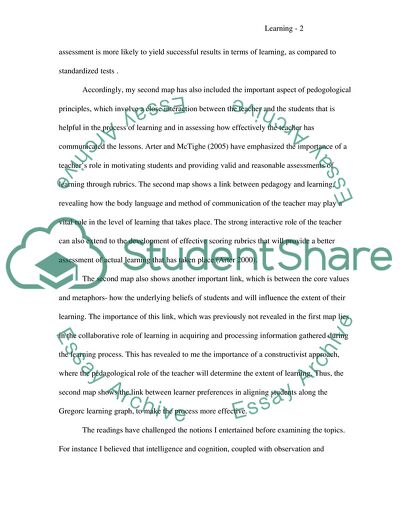
- Home
- Free Samples
- Premium Essays
- Editing Services
- Extra Tools
- Essay Writing Help
- About Us
- Studentshare
- Subjects
- Miscellaneous
- Education - Learning Theories
Education - Learning Theories - Essay Example

- Subject: Miscellaneous
- Type: Essay
- Level: Undergraduate
- Pages: 4 (1000 words)
- Downloads: 0
- Author: amyschaden
Extract of sample "Education - Learning Theories"
But these factors have been fleshed out in the second map and more detail added to them, to include some new words such as pedagogy, metaphors and graphs, as well as multiple intelligence as proposed by Gardiner. Moreover, other aspects such as collaborative learning are included in my second map. The new, key concepts that are present on my second map include pedagogy, metaphors and the importance of core values as factors influencing the learning process. While my first map showed tension as a factor arising out of the social context of learning, my second map includes this aspect within assessment, since such tension caused in students which in turn leads to inhibition in learning, is due to the fear of failure during assessment by the standardized test methods.
According to Stiggins and Chappuis (2005), classroom assessment is more likely to yield successful results in terms of learning, as compared to standardized tests . Accordingly, my second map has also included the important aspect of pedogological principles, which involve a close interaction between the teacher and the students that is helpful in the process of learning and in assessing how effectively the teacher has communicated the lessons. Arter and McTighe (2005) have emphasized the importance of a teacher’s role in motivating students and providing valid and reasonable assessments of learning through rubrics.
The second map shows a link between pedagogy and learning, revealing how the body language and method of communication of the teacher may play a vital role in the level of learning that takes place. The strong interactive role of the teacher can also extend to the development of effective scoring rubrics that will provide a better assessment of actual learning that has taken place.(Arter 2000). The second map also shows another important link,
...Download file to see next pages Read More
- TERMS & CONDITIONS
- PRIVACY POLICY
- COOKIES POLICY